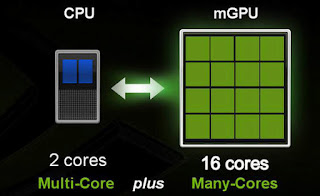Multi-Core and Many-Core Processors
Quoting the following information from http://www.argondesign.com
Single Core
Single Core
Processors
were originally developed with only one core, executing one thread at a
time. Programmers regularly employ "multithreading" to allow the
processor to switch between threads giving the impression that the
threads are running concurrently, although the tasks can only be
processed one at a time. The only way to improve processing throughput
is to run the core faster which requires more energy.
 |
| Image Reference: tomshardware.com |
MultiCore
A multicore
processor is typically made up of two, four, six or eight independent
processor cores in the same silicon connected through an on-chip bus, a
central intersection through which all information must flow between
processor cores or between cores and memory and I/O. Multicore
processors do execute threads concurrently, typically boost performance
in compute intensive processes and will use less power than coupling
multiple single-core processors. However as more cores are added the
on-chip bus creates an information traffic jam as all the data must
travel through the same path, limiting the benefits of multiple cores.
ManyCore
A manycore processor is one in which the number of cores is large enough
that traditional multi-processor techniques are no longer efficient,
such processors will either be more application specific or require a
different approach. Tilera addresses the multi-processor scalability
problem with a revolutionary new chip architecture that can harness the
processing power of hundreds of cores on a single chip, see Tilera
Technology; Tilera provides general purpose manycore processors with 16
to 100 identical processor cores (tiles) interconnected with Tilera's
iMesh™ on-chip network.
 |
| Image Reference: http://www.meetup.com |
Increasingly, applications demand more and more compute power. For now, we see this type of novel chip architecture used in High Performance Computing. However, it's not hard to imagine these more powerful processors make their way into handheld devices, smartphones and tablets, provided that we can write software to make efficient use of these new chip architectures.

Comments
Post a Comment